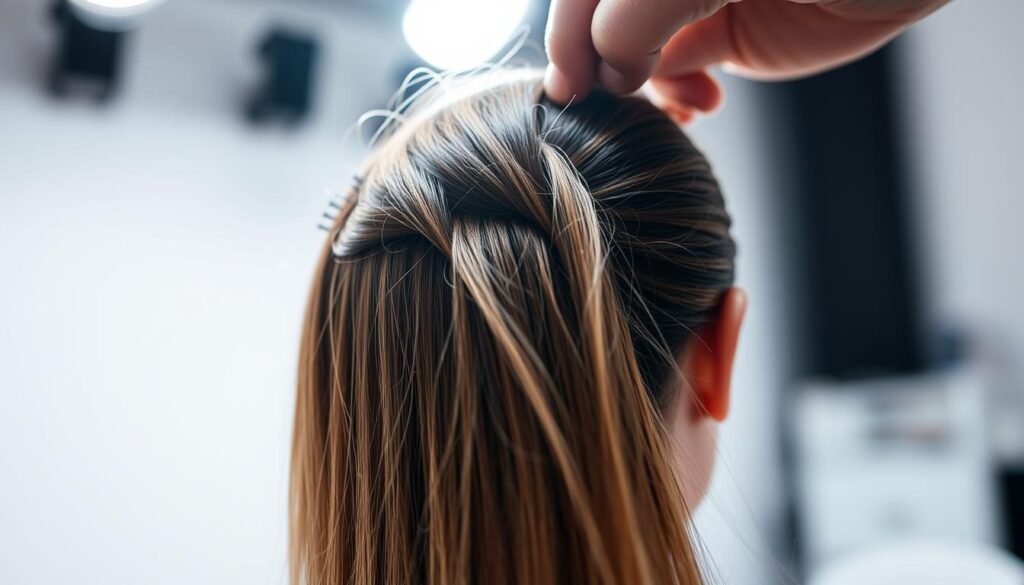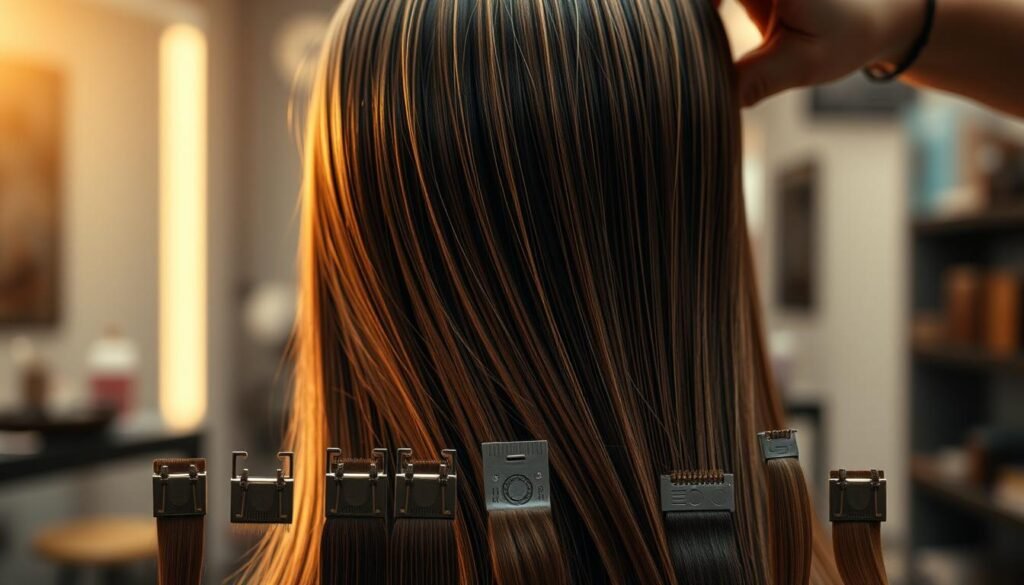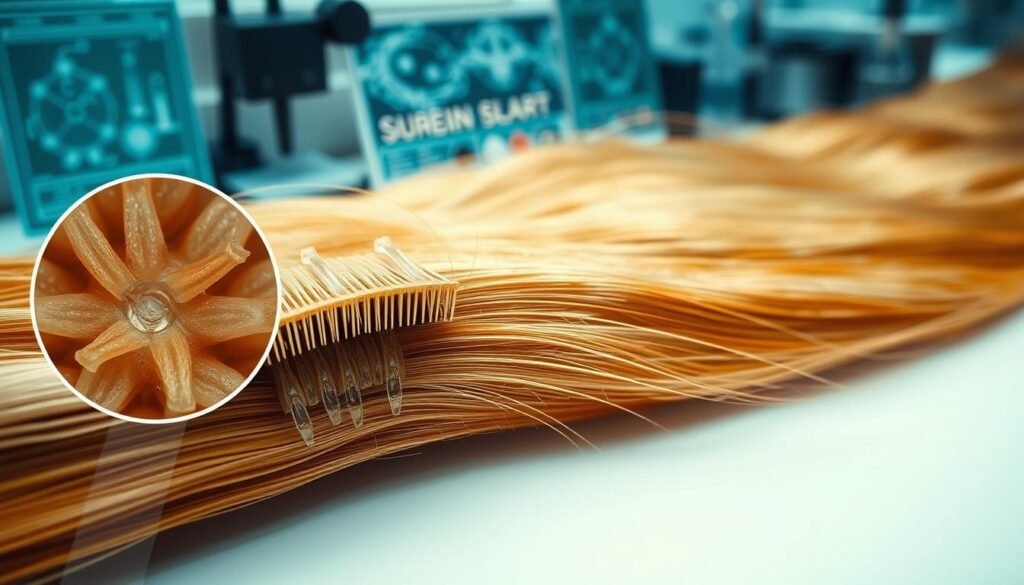Many people wonder if hair extensions are safe for their natural hair. Experts say that with the right application and care, extensions can be a great way to boost your natural beauty. This is true without harming your hair, which is key for hair extension safety and natural hair care1.
It’s important to weigh the risks and benefits of hair extensions. For example, there’s a 30% chance of poor blending between extensions and natural hair, leading to an unnatural look1.
If you’re thinking about getting hair extensions, picking a reputable stylist is crucial. Following the right care instructions can prevent issues like visible tracks or bonds, affecting 25% of users1. For more information on hair extension safety and natural hair care, visit hair extension specialists for expert advice and services.

Key Takeaways
- Hair extensions can be safe for natural hair if applied and maintained properly, which is a key aspect of hair extension safety and natural hair care.
- Poor blending between extensions and natural hair is one of the most common issues, leading to an unnatural appearance in approximately 30% of extension users1.
- Proper care and maintenance are essential to avoid common issues such as visible tracks or bonds and hair tangling and matting, which can be reported in 35% of users1.
- Choosing the right type of extensions for your hair type is crucial to avoid unsatisfactory results, which can affect up to 20% of users1.
- Clip-in hair extensions typically range in price from $100 to $350, while professionally installed long-wearing hair extensions can cost between $350 and upwards of $2,0002.
- Tape-in hair extensions can last for approximately two months before requiring maintenance, and microlink hair extensions can last up to two to three months2.
Understanding Hair Extensions: A Comprehensive Overview
There are many hair extension types out there, each with its own special features and benefits. Thanks to hair extension technology, we now have high-quality extensions that fit different hair types and needs3. You can choose from clip-in, tape-in, bonded, and micro-link extensions, among others3.
Choosing the right extension depends on your hair type, lifestyle, and what you like. For instance, remy hair is top-notch because it’s healthy and has its cuticles in the right direction3. But, synthetic hair is cheaper, though it might not last as long3.
Some popular hair extension types include:
- Clip-in extensions: easy to put on and take off, great for short-term use
- Tape-in extensions: semi-permanent, lasts up to 6-8 weeks4
- Bonded extensions: permanent, lasts up to 3-4 months4

Knowing about the different hair extension types helps you pick the best one for you. Think about hair growth, upkeep, and how to remove them5. With the right hair extension technology and care, you can have stunning, long-lasting hair extensions that boost your natural beauty.
The Science Behind Hair Extensions and Natural Hair
It’s important to know how hair extensions and natural hair work together. The natural hair structure is key in choosing the right extensions. If done right, extensions won’t harm your hair or stop it from growing6. But, if they’re too heavy or not attached well, they can cause hair loss6.
Knowing about hair extension science helps pick the best type for your hair. Hand-tied wefts are the least damaging, spreading tension evenly6. It’s also vital to get regular touch-ups every 6–8 weeks to keep your hair healthy6. Using gentle products and soft brushing helps too6.

Experts say hair extensions don’t directly cause hair loss. But, bad installation and care can damage your hair6. Problems include hair breakage, scalp irritation, and hair loss from constant tension6. Knowing about hair extensions and natural hair helps you make better choices for your hair care.
Are Hair Extensions Safe for My Natural Hair?
Many worry about the effects of hair extensions on natural hair risks. The right application and care can avoid damage to your natural hair7. But, bad quality extensions and wrong care can harm your hair, causing breakage and thinning7.
Yet, hair extensions can also protect your hair, especially if it’s fine or fragile7. High-quality extensions, applied correctly, can look like your own hair, making it look better7. With the right care, they can last for months7.
Some important points about hair extensions include:
- They can be styled like your own hair, if you use gentle, sulphate-free products8.
- Clip-in extensions are the most temporary, which means less damage8.
- Braidless hand-tied weft extensions are very gentle, as they don’t use braids, heat, or glue8.
In the end, hair extension safety and reducing natural hair risks depend on how well they’re installed, cared for, and the quality of the extensions78. Knowing these things and taking the right steps can help you enjoy hair extensions safely, protecting your natural hair.
Choosing the Right Type of Extensions for Your Hair
Choosing the right hair extension selection depends on your hair type and lifestyle. Fine hair needs lighter hair extension types, while thicker hair requires heavier ones9. For example, clip-in extensions are best for straight or wavy hair. On the other hand, tape-in or sew-in extensions suit curly or kinky hair textures9.
Think about these factors when making your choice:
- Hair type: Fine, medium, or coarse
- Lifestyle: Active, busy, or relaxed
- Personal preference: Temporary, semi-permanent, or permanent
Choosing the right color for your hair extension types is also key for a natural look9. Regular visits to a professional hairstylist are vital for tape-in and fusion extensions9. They help keep your extensions secure and in top shape. Using sulfate-free products and heat protectants also helps maintain the quality of your hair extension types10.
By considering these points and picking the right hair extension selection, you can have a safe and successful experience10. Always get advice from a professional hairstylist for the best guidance on hair extension types9.
Professional Installation vs DIY: What You Need to Know
Choosing between professional hair extension installation and DIY can be tough. DIY methods are popular for saving money11. But, it’s vital to weigh the risks and benefits. A pro stylist ensures a safe, successful install, keeping our natural hair healthy.
It’s important to pick the right hair extension type. Clip-in extensions are simple for beginners, needing little skill11. Tape-in extensions last weeks with the right care11. Bead extensions are gentle on our hair11. Clip-in extensions are the least damaging if applied and removed right12.
To find a good stylist, ask friends or check online reviews. A pro stylist guarantees a safe, successful install. Regular checks prevent matting and tangling, especially for permanent extensions12. With proper care, our extensions can last and look fabulous.
- Customized application to suit our hair type and style
- Minimized risk of damage or discomfort
- Longer-lasting results compared to DIY methods
Professional hair extension installation gives us a stunning, lasting look. With the right stylist and care, we can enjoy our extensions while keeping our natural hair healthy1112.
Signs That Your Extensions Are Damaging Your Hair
Many of us ignore the signs of hair extension damage, which can harm our hair long-term. It’s key to spot these signs early to prevent problems. Studies show13 that ignoring care can cause a 70% rise in tangling and matting.
Common damage signs include hair breakage, scalp irritation, and tangling. These problems can come from bad application, low-quality extensions, or too much heat14. To avoid damage, pick the right extensions and follow a good care routine.
Looking after your extensions well can greatly reduce damage risk. You should get regular maintenance every 6-8 weeks13. Also, using sulfate-free shampoos and protective styles at night can help keep your hair healthy14.
Knowing the signs of hair extension damage and acting to prevent it can lead to a healthy experience. Remember, hair health is as important as how your extensions look.
Proper Care and Maintenance Requirements
To keep your hair extensions looking great, you need a daily care routine. Use shampoos without sulfates and parabens to stop them from drying out too fast. This is important because 70% of users say it keeps their extensions moist15. Also, detangling gently can cut down tangling and matting by half, as people have reported15.
Don’t forget about weekly maintenance. Use heat protectants to lessen damage from heat by about 30%15. Applying moisture products, like a homemade hair mask, can keep your extensions hydrated. This stops dryness and brittleness in 80% of users15. Remember, not taking care of your extensions can lead to tangling and matting, common problems16.
Choosing the right products and tools is key for healthy extensions. Use a silk or satin pillowcase to stop tangling while you sleep15. And try to avoid using too many heat styling tools to prevent damage16. By doing these things and using the right products, you can enjoy your extensions for a long time.
- Using sulfate-free and paraben-free shampoos
- Applying heat protectant products
- Regularly applying moisture products
- Using a silk or satin pillowcase
- Avoiding excessive heat styling tools
By following these tips, you can keep your hair extensions looking healthy and vibrant. This way, you can enjoy them for a long time1516.
The Impact of Extension Weight on Hair Health
When we talk about hair extensions, the weight is a big deal. Heavy extensions can harm our natural hair, causing damage and even hair loss17. But, lightweight extensions are a good choice for adding volume or length without stressing our hair too much.
Choosing the right extensions is key. For example, tape-in and micro ring extensions are gentle on hair. They don’t use heat or glue, which is better for our hair17. Also, getting regular maintenance is important to keep extensions looking great18.
Looking after our extensions and natural hair is vital. We should use sulfate-free shampoos and avoid too much heat styling18. By doing this, we can reduce damage and keep our hair looking healthy and beautiful.
In short, the weight of hair extensions really matters for our hair health. By picking the right extensions, caring for them properly, and being aware of their weight, we can avoid damage. This way, we can enjoy a healthy and stunning hair extension experience17.
Best Practices for Protecting Your Natural Hair
Looking after your natural hair is key, especially when you have hair extensions. Natural hair is often fragile and can easily get damaged19. To avoid harm, it’s vital to follow some important hair care tips and use protective methods.
Wearing protective styles like braids and twists is good for your hair, especially if you have curly or coily hair19. Also, using a gentle shampoo without sulfates and not washing your hair too much can stop it from getting dry and brittle20.
Essential Hair Care Tips
- Use a wide-tooth comb or a detangling brush to gently comb out your hair, starting from the ends and working your way up.
- Avoid using heat styling tools or use a low-heat setting to prevent damage to hair fibers20.
- Use a microfiber towel or an old t-shirt to dry your hair, minimizing frizz and damage.
Protective Techniques
Keeping up with regular hair care, even in protective styles, is key to a healthy scalp19. Detangling hair extensions before and after washing is also important to avoid knots and tangles, especially for curly or textured extensions20.
By sticking to these tips and techniques, you can protect your natural hair and have a great hair extension experience. Always remember to put hair protection and care first to keep your hair looking beautiful and healthy.
Common Mistakes to Avoid with Hair Extensions
Many people have had bad experiences with hair extensions because of common hair extension mistakes. Knowing these mistakes helps you avoid them. For example, bad installation can cause discomfort and harm your natural hair21. Also, using heat tools too hot can damage your extensions21. Cheap extensions can lead to shedding, tangling, and matting21.
Other mistakes include poor blending, visible tracks or bonds, and tight extensions. To avoid these, choose good-quality extensions and follow hair extension tips. Regular washing and brushing are key21. Also, picking a skilled stylist is important for a good application and care advice.
For more details on avoiding hair extension mistakes, check out this website. It shares experiences to help you have a good hair extension time.
Expert Recommendations for Extension Wear
Expert advice is key when it comes to hair extensions. Over 55% of women face hair thinning at some point22. Choosing the right extensions and caring for them properly is vital to avoid damage.
Experts say clip-in extensions are the least damaging23. They use clips that don’t pull on your hair. Tape-in extensions can last 4-8 weeks if looked after well22. It’s also important to consider the weight of extensions, as heavy ones can harm your natural hair23.
To have a good experience with hair extensions, follow expert care tips. Use high-quality extensions and keep your hair clean and healthy before applying them. Avoid too much heat styling24. By doing this, you can enjoy your hair extensions safely and successfully. For more on hair extension care, visit hair extension care and terms of service for more details.
Understanding the Cost vs Quality Factor
When choosing hair extensions, we must think about the hair extension cost and hair extension quality. High-quality human hair extensions cost between $500 and $200025. This price reflects the detailed work, skilled labor, and special machines needed.
It’s important to balance the hair extension cost with the hair extension quality. Remy hair extensions, known for their quality, are pricier than others25. Yet, they last longer and look more natural. Non-permanent extensions are cheaper but need less professional care25.
Here are some key points to consider:
- Installation time and cost: Permanent extensions take 4-8 hours, while tape-ins only need 1-2 hours26.
- Maintenance and upkeep: Extensions should be checked every 6-8 weeks to keep them secure and prevent damage26.
- Geographical location: Prices vary by location, with big cities often charging more than smaller towns25.
To make a smart choice, we must look at both the hair extension cost and hair extension quality. By carefully considering these, we can find the right extensions for our budget and style.
When to Remove or Replace Your Extensions
Knowing when to remove or replace your hair extensions is key for your natural hair’s health. Regular maintenance helps avoid damage and ensures a safe experience. Tape-in extensions need repositioning or reinstallation every 6–8 weeks27. Other types might have different needs.
Watch out for signs that it’s time to remove or replace your extensions. These include excessive shedding or breakage, loss of volume, or damage to the extensions28. If you see these signs, get advice from a professional stylist.
Removing or replacing extensions should be done by a pro to protect your natural hair. A stylist can check your extensions and decide the best way to remove or replace them. With the right care, hair extensions can enhance your beauty, and regular maintenance ensures a safe experience29.
Understanding the need for hair extension removal and replacement is vital. It lets you enjoy your extensions while keeping your natural hair healthy. Always focus on regular maintenance and seek a professional stylist’s advice if you’re unsure about your extensions.
Conclusion: Making an Informed Decision About Hair Extensions
Hair extensions can change your look in many ways. But, they need careful thought. When it comes to hair extension decision, it’s key to choose wisely. This choice should match your hair type, lifestyle, and what you like30.
There are many types of extensions, like clip-ins and sew-ins. Each has its own level of commitment, upkeep, and cost31. It’s important to consider these factors. Getting advice from experts can help you find the best option for you. With proper care, extensions can boost your style without harming your natural hair30.
Choosing to get hair extensions is a personal choice. By knowing the science, risks, and how to care for them, you can make a smart choice. This choice lets you get the style you want while keeping your hair healthy30.
Source Links
- https://vampsalon.com/10-common-hair-extension-fails-and-how-expert-stylists-fix-them/
- https://www.popsugar.com/beauty/hair-extensions-48959472
- https://www.byrdie.com/hair-extensions-types
- https://www.elle.com/uk/beauty/hair/a26212/hair-extensions-guide-reviews/
- https://roxyhair.com/blogs/qa/do-hair-extensions-stop-your-hair-from-growing-understanding-your-natural-hair-growth?srsltid=AfmBOoojZmhDk4_7S5SzwDb2HboHdQQi8HFktcDHAPPtLaKPm3kVmV4P
- https://needshairstudio.com/hair-extensions-side-effects-are-they-worth-the-risk/
- https://www.rush.co.uk/blog/do-hair-extensions-damage-your-hair-and-other-misconceptions/71812
- https://www.rushsalon.ca/blog/are-hair-extensions-damaging-or-not
- https://www.koko-hair.co.uk/uncategorised/how-to-choose-the-right-hair-extensions-for-your-hair-type/
- https://www.cliphair.co.uk/blogs/hair-blog/which-hair-extensions-are-the-least-damaging?srsltid=AfmBOopVVYquvkBo3y0S2AwLqYS8SCDBpDuX2XplR6IUO_qnA6XhRgz1
- https://atelierextensions.com/blogs/news/what-are-easiest-hair-extensions-apply-yourself?srsltid=AfmBOopKK0u0ME3NYBPxfbDLT18MoHNgq4rK_5WDQubx_j36eVOm4FKK
- https://www.cliphair.co.uk/blogs/hair-blog/which-hair-extensions-are-the-least-damaging?srsltid=AfmBOorOpyryEZog_AgW7fYQjHwghWg1ZMIiI542B9UcmUB6bcFe2sno
- https://thelaurenashtyncollection.com/blogs/blog/do-hair-extensions-damage-your-hair-here-are-5-mistakes-to-avoid-at-all-costs?srsltid=AfmBOoo9wmGSfDm5A0asndfIr4wfhEOHOQu-fe9JHrhWyqw8Ol-qGW_1
- https://www.cliphair.co.uk/blogs/hair-blog/which-hair-extensions-are-the-least-damaging?srsltid=AfmBOorrlGPzY7CA14_K06Z4zorpCVCuVAhsYFPmJzs1LOF13ZlgwRnh
- https://www.invisiblebeadextensions.com/blog/ultimate-guide-maintaining-hair-extensions/
- https://www.beautyclublondon.co.uk/blog/hair-extensions-aftercare/
- https://gkhair.co.uk/blogs/all-blog-posts/do-hair-extensions-ruin-your-hair
- https://thelaurenashtyncollection.com/blogs/blog/do-hair-extensions-damage-your-hair-here-are-5-mistakes-to-avoid-at-all-costs?srsltid=AfmBOorM0h301GU8PiSSo4oEq8qW5WxdSS4KcFAbAeYRTAyouKvOJUQy
- https://www.lorealparisusa.com/beauty-magazine/hair-style/updo-and-bun-hairstyles/natural-hair-protective-hairstyles
- https://www.perfectlocks.com/blogs/all-tressed-up/how-to-wash-hair-extensions?srsltid=AfmBOorEskWC7-bhkdoGaVV73ld9EDmGPfqN44gb8SHid5qljPwjyADm
- https://swayhairextensions.com/blogs/news/the-most-common-hair-extension-mistakes-and-how-to-avoid-them
- https://wimpoleclinic.com/blog/hair-extensions-for-thickness/
- https://usahair.com/blog/what-are-the-least-damaging-hair-extensions-a-comprehensive-guide.html?srsltid=AfmBOoq6-EhDR9JAJJdmvXuqH6-yNKQM8nSZapR_NyLB63FTgJAPEDXG
- https://atelierextensions.com/blogs/news/best-hair-extension-methods-different-hair-types?srsltid=AfmBOopzE0fRru_4lZLsxG73ClgOtZOz1Acw13IAbu6kx3Dx351s5-IF
- https://www.filomenasalonspa.com/blogs/why-are-hair-extensions-so-expensive
- https://wimpoleclinic.com/blog/permanent-hair-extensions/
- https://www.beautyclublondon.co.uk/blog/how-long-do-tape-extensions-last/
- https://noellesalon.com/blogs/hair-color-style/how-long-does-hair-extensions-last-key-info?srsltid=AfmBOopRlKUcRw1gau4lXbAd2DVzxE-z6jPmUkRlB5A72soZvjoX6seL
- https://iloveslavichair.com/least-damaging-hair-extensions?srsltid=AfmBOoqHrlKxf1-miOhBaskz1VNFerKJ2UCle4mxWetSWtjPMXZfQv_K
- https://vampsalon.com/the-pros-and-cons-of-different-hair-extension-types/
- https://trademarksalon.com/hair-extensions-everything-you-need-to-know/

